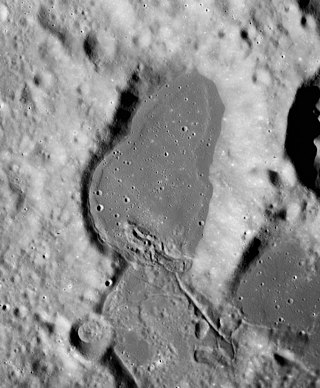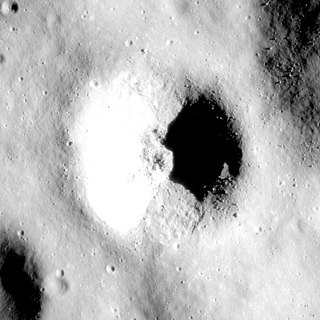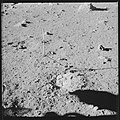
Alphonsus is an ancient impact crater on the Moon that dates from the pre-Nectarian era. It is located on the lunar highlands on the eastern end of Mare Nubium, west of the Imbrian Highlands, and slightly overlaps the crater Ptolemaeus to the north. To the southwest is the smaller Alpetragius. The crater name was approved by the IAU in 1935.

King is a prominent lunar impact crater that is located on the far side of the Moon, and can not be viewed directly from Earth. The crater was named after Arthur Scott King and Edward Skinner King in 1970. Prior to that, this crater was known as Crater 211. It forms a pair with Ibn Firnas, which is only slightly larger and is attached to the northeast rim of King. To the northwest is the crater Lobachevskiy, and Guyot is located an equal distance to the north-northwest.

Bowditch is a lunar impact crater that lies on the far side of the Moon, just beyond the eastern limb. It is located on a region of the lunar surface that is brought into view due to libration, but at such times the area is viewed from the edge and so not much detail can be observed. It lies just to the north of the small Lacus Solitudinis lunar mare, between the craters Titius to the southwest and Perel'man to the east-northeast.

Bečvář is a lunar impact crater that is located near the equator on the far side of the Moon. It lies to the northeast of the crater Necho, within that feature's ray system. To the north-northeast is the crater Gregory.

Dollond is a small lunar impact crater that is located in the central region of the Moon, to the north of the crater Abulfeda. It was named after British optician John Dollond. Due west of Dollond is Anděl. Dollond is circular and cone shaped, with a tiny floor at the midpoint of the sloping interior walls.

Dryden is a lunar impact crater that is located on the southern hemisphere on the far side of the Moon. It lies within the huge walled plain called Apollo, and is one of several features within that basin named after people associated with the Apollo program. Apollo itself has an inner ring, and Dryden is attached to the west-northwest part of that circular mountain formation. To the south of Dryden along the same range is the crater Chaffee.

Mons Hadley is a massif in the northern portion of the Montes Apenninus, a range in the northern hemisphere of the Moon. It has a height of 4.5 km (2.8 mi) 14,764 ft (4,500 m) above the adjacent plain and a maximum diameter of 25 km at the base.

Planté is a lunar crater that is situated near the eastern inner wall of the much larger crater Keeler. Just to the east, attached to the exterior of Keeler, is the large crater Heaviside. Planté is located on the far side of the Moon and cannot be viewed directly from the Earth.

Mandelʹshtam is the remains of a large crater on the Moon's far side named after Leonid Mandelstam. Nearly attached to the northeast outer rim is the crater Papaleksi. To the south lies the crater Vening Meinesz.

Konstantinov is a lunar impact crater that is located to the southeast of the Mare Moscoviense, on the far side of the Moon. To the west of Konstantinov is the smaller crater Nagaoka, and to the south-southeast is the small Van Gent.

Pannekoek is a lunar impact crater that is situated on the far side of the Moon, and cannot be seen directly from the Earth. The crater lies along the northern edge of the slightly larger Dellinger, and their common border forms an area of uneven terrain. Due north of Pannekoek is the huge walled plain Mendeleev. Glazenap crater is to the northwest.

Meitner is an impact crater on the far side of the Moon, behind the eastern limb. It lies to the northwest of the crater Kondratyuk, and about a crater diameter to the west of Langemak.

North Ray crater is a small crater in the Descartes Highlands of the Moon visited by the astronauts of Apollo 16. The name of the crater was formally adopted by the IAU in 1973. It is the largest crater sampled by astronauts during the Apollo program.

Flag crater is a small crater in the Descartes Highlands of the Moon visited by the astronauts of Apollo 16. The name of the crater was formally adopted by the IAU in 1973. Geology Station 1 is adjacent to Flag, at the much smaller Plum crater.

Spook crater is a small crater in the Descartes Highlands of the Moon visited by the astronauts of Apollo 16. The name of the crater was formally adopted by the IAU in 1973. Geology Station 2 is adjacent to Spook, between it and the smaller, younger crater called Buster to the north of it.

Cinco is a small crater in the Descartes Highlands of the Moon visited by the astronauts of Apollo 16. The crater is one of a group of five (hence the name, Spanish for five) craters that were collectively called the Cinco craters during the Apollo 16 mission. The craters were designated a, b, c, d, and e, and the largest (a) was officially named Cinco after the mission in 1973 by the IAU.

Surveyor crater is a small crater in Mare Cognitum on the Moon. The name of the crater was formally adopted by the IAU in 1973.

Head crater is a small crater in Mare Cognitum on the Moon. The name of the crater was formally adopted by the IAU in 1973.

Sharp-Apollo crater is a small crater in Mare Cognitum on the Moon. The name of the crater was formally adopted by the IAU in 1973.

Halo crater is a small crater in Mare Cognitum on the Moon. The name of the crater was formally adopted by the IAU in 1973.






















